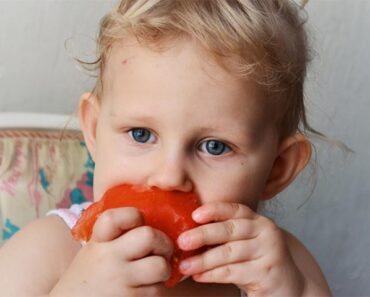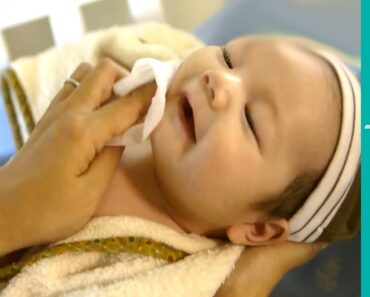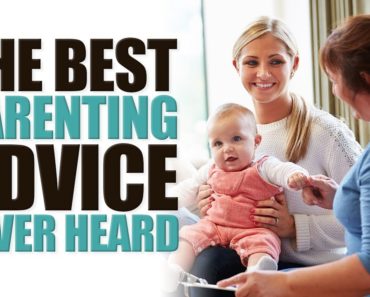Hypothermia or low temperature is a condition in which the body temperature drops below the normal range. It can occur in both adults and babies, but neonatal hypothermia could be a concern as infants cannot maintain their body temperature. If not detected early, low body temperature in babies could be a serious problem, although it rarely leads to mortality (1).
This post tells you about the symptoms, causes, and tips to prevent low temperature in babies.
How To Know If Your Baby Has Low Temperature?
According to the guidelines released by the Whole Health Organization (WHO), essential care is required during delivery and the initial days after birth as a newborn’s body is not yet developed to regulate the body temperature.
The average body temperature of an infant ranges between 35.5℃ and 37.5℃ when measured orally, 36.6℃ and 38℃ when measured rectally, 35.8℃ and 38℃ when measured through the ear, and 36.5℃ and 37.5℃ when measured in the armpit.
Your baby is said to be hypothermic when their body temperature drops below 36.5℃. This condition can be classified into three stages:
- Cold stress — 36.0–36.4℃
- Moderate hyperthermia — 32.0–35.9℃
- Severe hypothermia — 32℃ (1)
It is recommended that you measure the temperature of babies below five years of age through the rectum for an accurate reading (2).
Signs Of Hypothermia In Babies
It is important to detect the signs of hypothermia in your baby early on, as it would help you identify it in the early stages. Below are some of the first signs that might indicate the cold stress stage.
- The feet become cold before the body gets cold.
- Weakness or inability to suck while breastfeeding
- Sluggish and slow reactivity to stimuli
- Weak and shallow cry
Beyond this stage, the baby would be at risk of developing a cold injury, which is characterized by lethargy; slow, shallow, and irregular perspiration; slow heart rate; low blood sugar; and metabolic acidosis.
Other severe symptoms of hypothermia include reddening of the face and extremities, central cyanosis, and hardening of the skin on the back and limbs (1). These symptoms are risky and might need medical attention.
Next, let us look at some of the causes of low body temperature in babies.
Causes Of Low Body Temperature
Hypothermia is a serious yet preventable complication in babies. Knowing the causes of low body temperature might help you prevent it.
1. Prematurity and low birth weight
Infants born with a birth weight less than 1,500g and born at a gestation period of fewer than 28 weeks are at a 30 to 78% chance of developing hypothermia.
Preterm and low birth weight babies are at a higher risk of developing hypothermia because of the following factors.
- A large surface-area-to-volume ratio
- Immature skin with minimal stratum corneum
- A thin layer of insulating fat
- Lack of heat production in the body
Also, environmental factors, such as low ambient air temperature and low surface temperature of the beds, might contribute to hypothermia in preterm babies.
If a baby is about to be born preterm or with low birth weight, the baby should be wrapped in a polyethylene wrap (to prevent drying) immediately after the delivery. Heated mattresses can also be used to keep the baby warm (3).
2. Environmental factors
Environmental factors during birth might cause the newborn’s body to lose heat, leading to hypothermia. Within the first minutes after birth, the baby’s skin temperature falls by 3 to 4℃. Leaving the baby unattended after birth, delaying the drying and wrapping, and bathing the baby immediately after birth may increase the risk of hypothermia in newborns (4).
3. Hypoglycemia
Hypoglycemia can also cause hypothermia in babies. It is a condition in which the blood sugar or glucose levels are low in the body. Babies can become hypoglycemic at birth or later. It is usually seen in
- Babies with intrauterine growth restriction (IUGR)
- Babies of Diabetic mothers or large-for-gestational-age (LGA) infants
- Preterm babies of 34–36.6 weeks
- Babies born to a family with a history of diabetes (5)
4. Infections
In a few cases, hypothermia can be a symptom of severe infections in babies. Two such infections are meningitis and neonatal sepsis.
Meningitis is a bacterial infection that causes inflammation of the spinal cord membranes. It may cause fever in some babies, and there may be a drop in the body temperature in others. Along with hypothermia, you may also notice symptoms such as irritability, lethargy, feeding difficulties, respiratory distress, and seizures (6).
Sepsis refers to the body’s extreme reaction to a bacterial infection. In newborns, it may lead to inflammation and organ failure. A drop in body temperature is one of the symptoms of sepsis. Along with hypothermia, you may also notice feeding difficulties, irritability, vomiting, and lethargy (7).
Both these infections are severe in neonates, and they may require medical help.
5. Deficiencies
Some rare metabolic disorders such as Aromatic L-amino acid decarboxylase deficiency, Menkes disease, and Coenzyme Q10 deficiency may also cause a drop in the body temperature in babies. These are rare and may cause lethargy, feeding difficulties, seizures, and weak muscle tone.
Additional risk factors include:
- A large body surface area in relation to their weight
- A large head in proportion to the body as newborns lose 75% of body heat through the uncovered head.
- Asphyxia (low oxygen levels) (1)
If you spot any of the above signs and risk factors, it is best to talk to your pediatrician.
The next section covers a few ways in which you can prevent hypothermia in babies.
How To Prevent Hypothermia In A Newborn?
If your baby’s doctor rules out underlying medical reasons, hypothermia can be prevented in babies. First and foremost, appropriate care should be taken during and after delivery to avoid the loss of temperature from the body. The baby should not be left unattended and bare on a table or the bed.
Here are a few steps you can take:
- Ensure the hospital adheres to the warm chain system of keeping the baby warm to prevent hypothermia during birth. The warm chain is a set of interlinked events, including.
- Keeping the delivery room clean and at the optimal room temperature
- Ensuring the room does not have a draught through the windows or doors
- Immediately drying the infant with a clean towel and avoiding bathing at this time
- Wrapping the baby in layers of loose clothing and never placing them naked on a table
- Encouraging skin-to-skin contact with the mother and initiating breastfeeding
All these steps are applicable to full-term babies with normal vital signs, too. If your baby is born prematurely, talk to your doctor for special care instructions.
- Once your baby is home, you can try some of the below techniques to keep the baby warm.
- Always keep your baby covered in layers of loose-fitting clothes, and make sure their head is always covered.
- Swaddle the baby in a single blanket; however, follow the safety rules while doing it.
- According to the American Academy of Pediatrics, tub baths should be postponed until the umbilical cord falls off. Instead, a sponge bath should be given (8). This also helps limit the evaporation of moisture from the body.
- Follow the Kangaroo method in which the baby is placed in between the mother’s breasts wearing nothing except a diaper.
- Bathe the baby with lukewarm water. Do not let them be in the water for an extended period, and make sure you wrap them in a dry towel immediately after the bath.
- To help prevent hypoglycemia in babies, speak to your doctor, and maintain a healthy diet during pregnancy.
If your baby is sluggish or has feeding difficulties, keep monitoring their body temperature and track the changes in temperature to determine if your baby is suffering from hypothermia. Low temperature in babies is a serious problem and requires immediate action. Also, measure their temperature through the rectum for an accurate reading.
When you record a lower temperature than the normal range, try swaddling them or giving them skin-to-skin contact. Whether the condition improves or not, ensure you talk to your pediatrician.

































